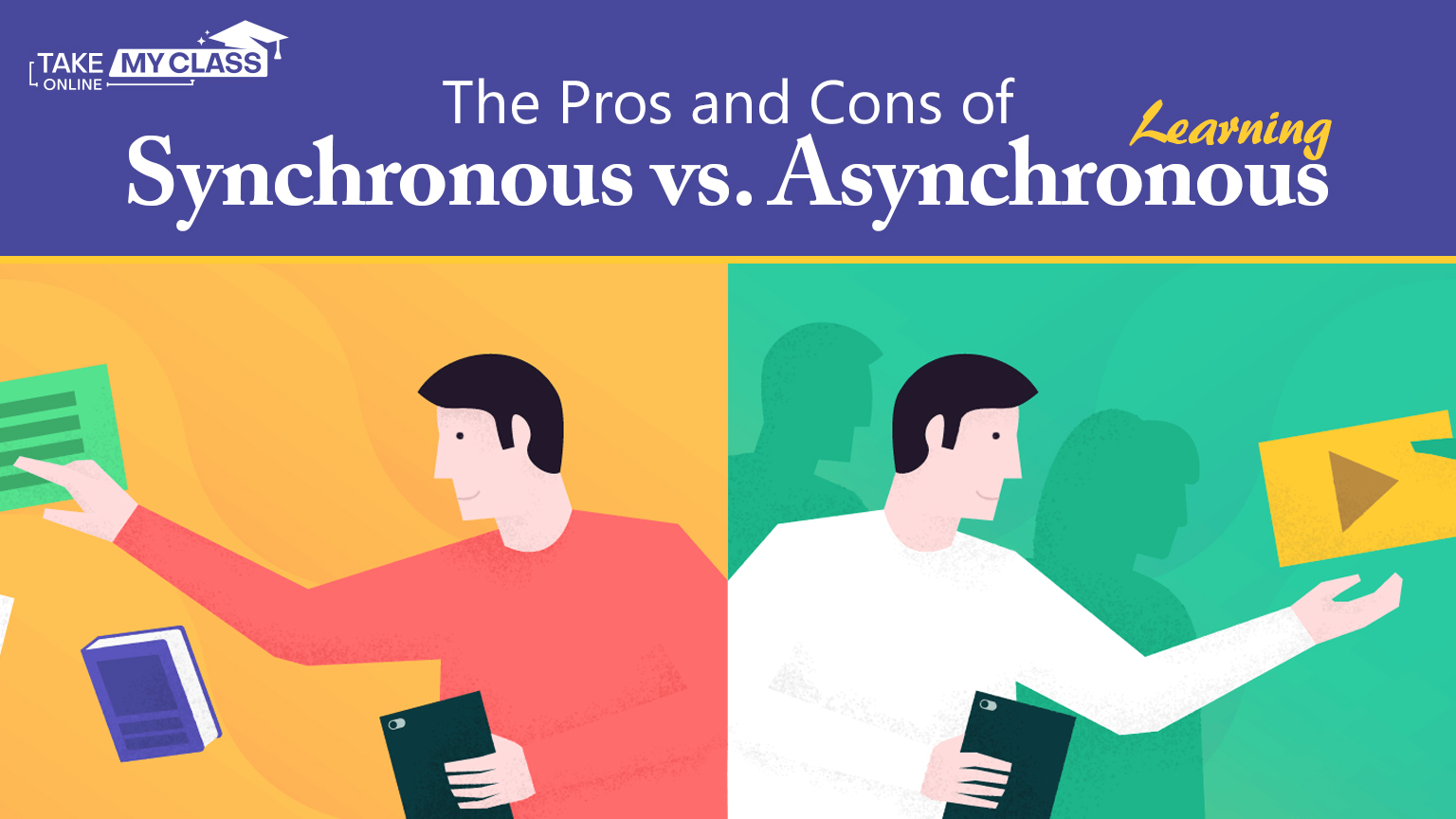
The Pros and Cons of Synchronous vs. Asynchronous Learning
With the changing paradigms of education, knowledge of synchronous vs asynchronous learning has become imperative. Synchronous and asynchronous learning each come with advantages and challenges. These affect how students access content. They also impact interaction with instructors and peers.
The blog discusses what is synchronous and asynchronous learning while providing insight for discerning path decisions that a learner may want to take. Let’s break down how sync and async models work in modern education.
If you’re someone thinking, “Can someone take my online class for me?” or “Is there a way to do my class online for me while I work full-time?”, understanding synchronous and asynchronous learning models can help you plan smarter. The synchronous vs asynchronous options give you flexibility based on your needs.
Defining Synchronous Learning
When comparing asynchronous learning vs synchronous learning, the latter happens in real time. It uses tools like video calls and live chats. Everyone logs in together. In synchronous and asynchronous models, timing is key. Teachers speak live, and students interact instantly. Classes are scheduled on fixed days and times.
This form of learning feels like a real classroom. Students follow a set structure. Discussions happen live. Feedback is immediate. Most online class help services also support this model.
It works best when real-time communication is needed. Let’s look deeper at how this helps students.
Understanding Asynchronous Learning
Synchronous and asynchronous learning differ in how time is used. Asynchronous learning happens at any time. Students access materials when they choose. Lectures are pre-recorded. Assignments are posted on portals. There’s no fixed class time.
Learners don’t meet instructors in person. They complete tasks at their own pace. The sync and async model fit busy students and working professionals. You control your schedule and learning speed.
It is something that many prefer, but it still entails having self-discipline. Let’s examine both in greater detail. Nowadays, many institutions provide both synchronous vs asynchronous models to cater to diverse needs.
Comparison Between Synchronous Learning and Asynchronous Learning
Both synchronous and asynchronous methods differ in their pros and cons, benefits and disadvantages. The choice of sync and async depends on the personal goal of engaging in either, the personal habits and daily life. This is the way synchronous and asynchronous are weighed against each other:
Synchronous Learning
| Advantages | Disadvantages |
|---|---|
|
|
Asynchronous Learning
| Advantages | Disadvantages |
|---|---|
|
|
Real-Life Scenarios: Asynchronous Learning vs Synchronous Learning
Let’s say you’re a parent who also works full time. You might prefer asynchronous learning vs synchronous learning because it gives you freedom. You can watch lectures after the kids go to bed and submit assignments on weekends. Finding a balance between synchronous vs asynchronous methods may unlock the true potential of online education.
On the other hand, a student just out of high school might benefit more from synchronous and asynchronous blended models. Blending synchronous vs asynchronous options allows for better time management. The sync and async approach give them structure while allowing time to explore and work independently.
Which One is Better?
There’s no clear winner in the synchronous vs asynchronous debate. Both offer powerful tools for learning. In many cases, asynchronous learning vs synchronous learning can shape how effectively a learner absorbs material. Educators who use such models give students a dynamic experience. With the power of sync and async, learners can reach their goals on their terms.
While synchronous vs asynchronous learning continues to evolve, students benefit from having more control. The best choice depends on your personality, lifestyle, and academic goals, and whether you prefer synchronous and asynchronous learning models.
Choose synchronous learning if you:
- Like structure and routine
- Need real-time help
- Enjoy class discussions
Choose asynchronous learning if you:
- Need schedule flexibility
- Work or care for others
- Prefer learning at your own pace.
Sometimes, schools blend both formats. The synchronous vs asynchronous mix lets you watch recorded lectures and attend live Q&A sessions. Still, others may find themselves benefitting from structure in asynchronous learning vs synchronous learning approaches when offered together. With this hybrid model of sync and async, you are enjoying both worlds.
If you are looking for the best online class help reviews or expert guidance, TMCO is the go-to. Synchronous vs asynchronous learning is all covered, and they help you stay ahead.
Tips to Succeed in Either Format
Be successful in any format. It’s all about planning and being consistent in a sync or async model: success also depends on synchronous vs asynchronous how to use each model of learning. The following tips should help in focusing and pacing oneself through both synchronous and asynchronous learning environments.
- Organise yourself: Always track the deadlines with a calendar and a reminder.
- Take part: Ask questions in the live session or on the discussion board.
- Communicate: Do not hesitate to talk or email your instructor.
- Regular review: Re-watch the video, re-read the material for reinforcement of learning.
If you want online class help or already enrolled and contemplating a switch, knowing the difference between synchronous vs asynchronous learning can help you realise success.
With more and more people shifting to digital learning, sync and async is on the rise now. Be it forums or live discussions, it serves the purpose of propelling engagement. The synchronous vs asynchronous models are flexibility and structure according to personal needs.
Synchronous and asynchronous learning can be quite different, even so much! For students who work and study, the benefits are many between synchronous and asynchronous learning. Some learners alternate sync with synchronous vs asynchronous.
While variable schedule attendees may see asynchronous learning as a viable option, synchronous classes typically cater more to students who thrive in an interactive atmosphere.
Conclusion
Both synchronous and asynchronous learning offer unique advantages and disadvantages regarding the learning situation. Knowledge of the characteristics and timing permits students to choose the format that best fits their learning style and personal situations.
Thus, the whole educational experience will improve if educational institutions and teachers adapt their teaching strategies to correspond to these various learning needs and backgrounds.
Frequently Asked Questions
Explain synchronous and asynchronous learning in simple words?
Synchronous learning allows for live interaction, whereas the asynchronous format is self-paced and flexible.
Which is better: synchronous or asynchronous learning?
This completely depends on the needs of the learner. Some prefer structure, whereas others like flexibility.
Why do students like asynchronous learning?
Because they want to be in control of their time and go back and check the lessons whenever they want.
Can I change from synchronous and asynchronous learning?
Yes. Many platforms provide both methods, applying hybrid/flexible solutions.
Is it harder to learn asynchronously than it is synchronously?
For some individuals, yes, as it demands constant motivation and self-scheduling.
The greatest benefit of synchronous learning?
Live interaction and instant feedback from the teacher and peers.
The Best Price Offers You’ve Seen
| Full Class | $ 99/ Week |
| Homework | $ 79/ Week |
| Test or Quiz | $ 99/ Week |
| Essay or Paper | $ 39/ Week |
| Project | $ 99/ Week |
![]()
Your privacy is our top-most priority and that is why we are using SSL certified platform to secure your data.
